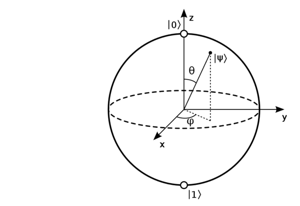As we can see here (https://eye.kohei-kevin.com/2023/07/01/note-machine-learning-with-quantum-computers-2/), a pure state vector is represented as following
\begin{align}
\ket{\psi} = cos{\theta\over2}\ket{0}+exp(i\phi)sin{\theta\over2}\ket{1}
\end{align}But, if we use density matrix representation, it is written as
\begin{align}
\ket{\psi}\bra{\psi}=
\begin{pmatrix}
\cos^2(\frac{\theta}{2}) & e^{-i\phi} sin(\frac{\theta}{2})cos(\frac{\theta}{2})\\
e^{i\phi} sin(\frac{\theta}{2})cos(\frac{\theta}{2}) & \sin^2(\frac{\theta}{2})
\end{pmatrix}
\end{align}And if we use the Pauli matrices, it turns like this
\begin{align}
\ket{\psi}\bra{\psi}
=\frac{1}{2}(I+cos(\phi)sin(\theta)X+sin(\theta)sin(\phi)Y+cos(\theta)Z)\\
X = \begin{pmatrix} 0 & 1 \\ 1 & 0 \end{pmatrix}, \space
Y = \begin{pmatrix} 0 & -i \\ i & 0 \end{pmatrix}, \space
Z = \begin{pmatrix} 1 & 0 \\ 0 & -1 \end{pmatrix}
\end{align}I, X, Y and Z are a linear basis in two-dimensional complex space. (https://eye.kohei-kevin.com/2024/05/24/special-unitary-group/)
The pure state of one qubit in which a, b and c (which is on unit ball in 3D space) can be written as follows:
\frac{1}{2}(I+aX+bY+cZ)\\
a^2+b^2+c^2=1Linear Combination of Pauli Matrix to represent any imaginary matrix.
Note that basis function of an any 2 dimensional square imaginary matrices are I, X, Y and Z.
Because these matrices are linearly independent.
\begin{align}
when \space aI+bX+cY+cZ=0, \\
a=b=c=d=0
\end{align}